The Art of Major Joseph C. Hazen, Jr., U.S.A. |
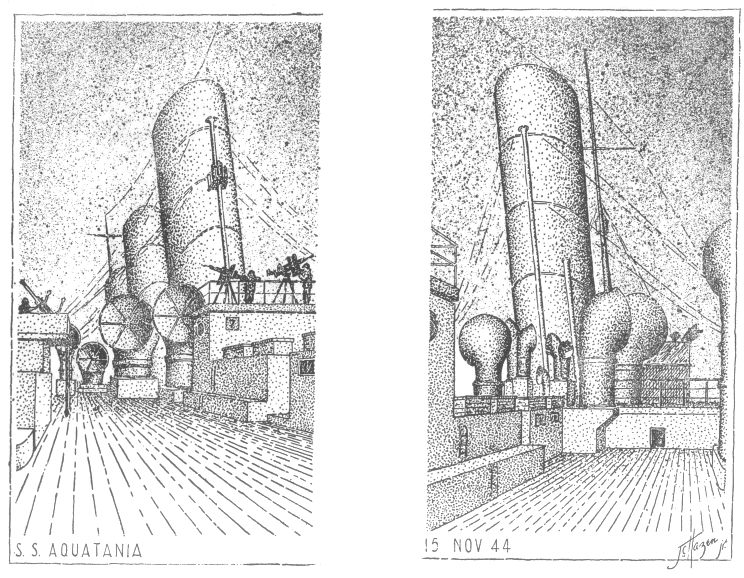 |
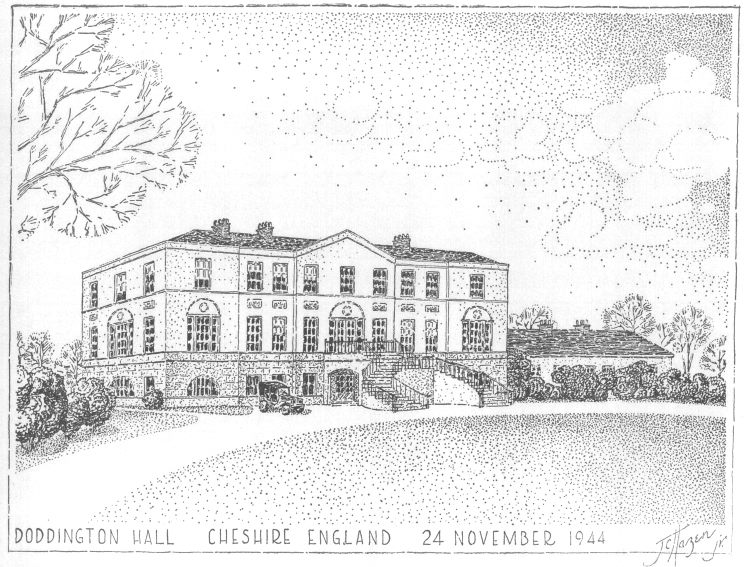 |
The estate where 15th Army was billeted in England. |
 |
The estate where 15th Army was billeted in England. |
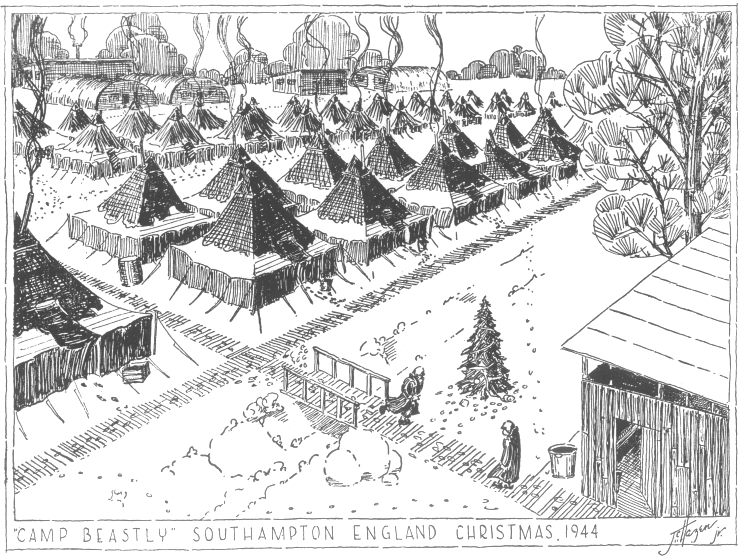 |
The staging area in Southampton, England. |
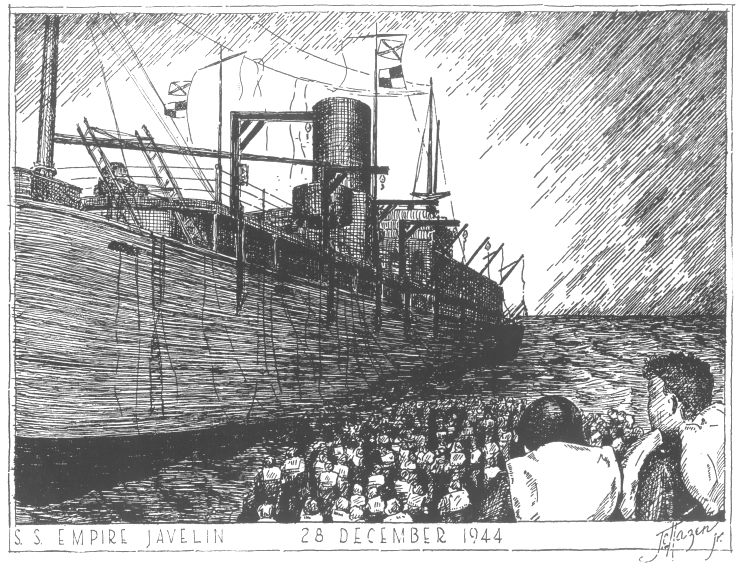 |
The Empire Javelin in which 15th Army Headquarters was being transported to France, she struck a mine on December 28, 1944 in the English Channel and sank. (To read Maj. Hazen's Account of the Loss of the Empire Javelin click here.) |
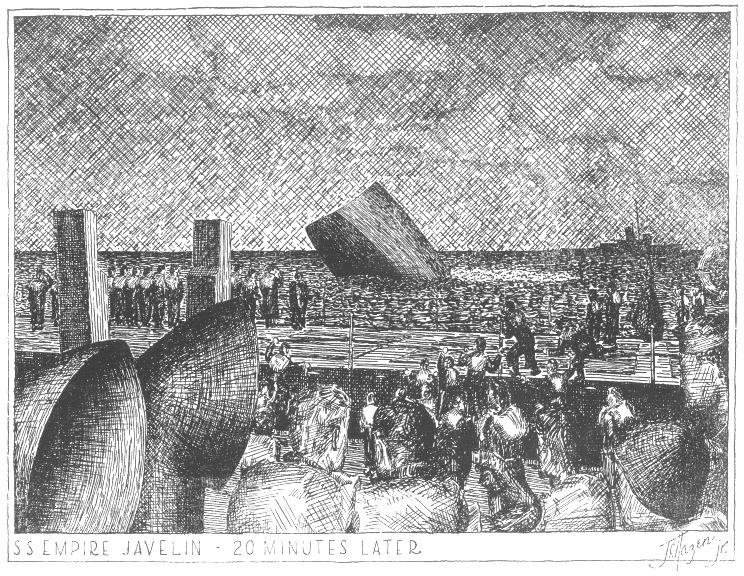 |
The Empire Javelin about to go under. (To read Maj. Hazen's Account of the Loss of the Empire Javelin click here.) |
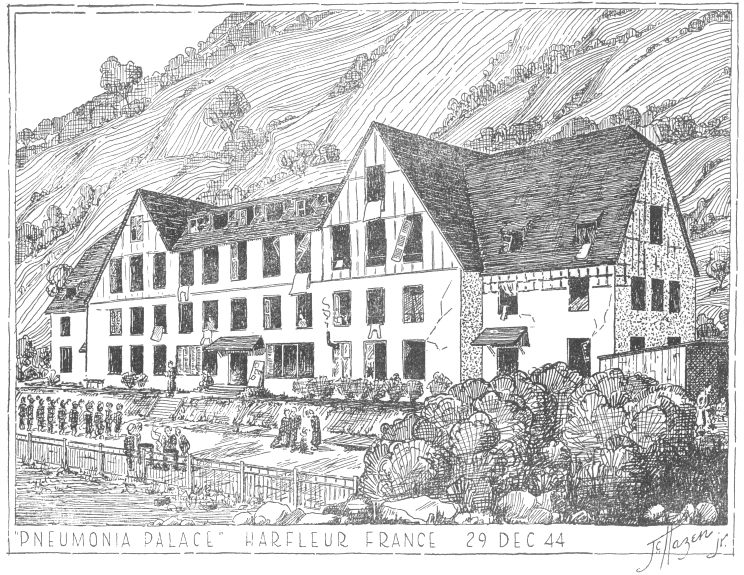 |
Presumably one of the buildings where some of the men of the 15th Army were taken to after the sinking. |
(Images courtesy of Dr. Bert R. Bratton, M.D.) |
Dec. 19, 2010 These sketched made by J. C. Hazen, Jr. depict the movements of 15th U.S. Army Headquarters from the time they crossed the Atlantic until they arrived in France in late 1944, including the sinking of the Empire Javelin. The sketches are part of the collection of Bert L. Bratton, a 15th Army soldier, and were given to MaritimeQuest by his son, Bert R. Bratton, M.D. It is assumed that Mr. Hazen was a member of the 15th Army, however we have no other information about him. If you have any information about Mr. Hazen please email the webmaster (michael@maritimequest.com). We thank Dr. Bratton for taking the time to have these sketched scanned and for allowing MaritimeQuest to publish the collection. |
1. Sept. 4, 2011 I was in the Artillery Section of the 15th U.S. Army Headquarters with Major Joseph C. Hazen, Jr. We served together from England to our last station in Bad Nauheim, Germany. I still have 7 of the "prints" and they are personally signed by him. I seem to remember that some of the first reproductions were on German posters and the printer had used the reverse side. Are you in the business of selling prints? Not sure what info I saw when I was on the web originally. Went back to Normandy last fall and attempted to locate the "pneumonia palace" in Harfleur, but it has been torn down and no one I talked with remembered it. Sincerely, Ellis Titche 15th Army Artillery Section |
2. Sept. 20, 2011 Joseph C. Hazen, Jr. Class of 1935 Published in the Princeton Alumni Weekly, July 7, 2010 Joe died May 13, 2005, in Essex Meadows, Conn. Born in Janesville, Wis., and raised in Illinois and New Jersey, he came to Princeton from the Peddie School. At Princeton, Joe majored in architecture, ate at Cannon, and engaged in many activities, including Triangle, the Princeton Tiger, varsity swimming, and 150-pound crew. Senior year he roomed with Pete Keenan, Tony Rytina, and Johnny Sylvester. Joe spent his entire career with Time Inc., retiring as general manager of Time-Life Books. He served on community planning boards in the New Jersey towns where he lived and also was a trustee of Martha's Vineyard Preservation Trust. Retiring in 1972, he began a new career in residential architecture and art, with many one-man shows of his serigraphs throughout the Northeast. During World War II, Joe served as an Army artillery officer in the United States and in the European theater, winning a Bronze Star. At his death he was our class secretary, having served earlier as president, and was a Reunions stalwart. Joe's wife, Helen, died in 1981 after 43 years of marriage. Joe also was predeceased by his brother Burchard ("Beach") '36. He is survived by a daughter, Libby; son Joseph III ("Jay") '63; four grandchildren, including John Hazen '89; and five great-grandchildren. |
3. May 3, 2015 I received the following letter today from Charles Cowie, whose father was a survivor of the Empire Javelin. It was written by Maj. Hazen on July 18, 1945 and describes the prints seen above. |
As I think I told you before, I'm running a little private art business on the side, and it has been keeping me pretty busy after office hours. Official business now stops at 5:30, so I have most of the evenings to myself. I've made seven sketches in pen and ink of scenes which are meaningful to those who have been with the Fifteenth since we sailed from the US. Several fellows suggested that I have them reproduced so that they might have copies. That gave me an idea which has developed into quite a business. First I took orders for the reproduction, then I found a place here in Germany which could handle the reproduction of them by the photoengraving process. Last week I picked up the copies. This week I've been filling the orders and collecting the Marks. Now I'm sold out and have so many new orders that I'm planning to have some additional copies run off in the immediate future. I've sold the sketches to the enlisted men for 75 cents each and to the officers for $1 each. I didn't realize how big the demand would be when I set the prices, but everyone says that they are fair. To date, I've actually collected a little more than $1,000.00! Imagine! Every one has commented so favorably upon my efforts that I've decided to make another drawing which I will give to everyone - it will be comprised of several small sketches of incidents along our long journey and will be of a somewhat humorous or burlesque nature. I have mailed you a set of the seven money-making sketches. I put them in the mail yesterday, and, since they are traveling first class, they should reach you in a couple of weeks. Here's a little verbal description to go with each of the sketches. 1 - SS Aquatania: Two sketches - one looking forward and one looking aft - made on the top. (life boat) deck of the big ship. The sketches indicate that the trip was a foggy one. 2 - Doddington Hall: This is the tremendous mansion in which we lived while we were in England. Although about 40 years old, it is still an attractive place. My room was on the ground floor - a corner room at the left rear. Doddington -Estate is near Crewe - about 40 miles due south of Manchester. Cheshire is the county. 3 - Tower on Doddington Estate - This tower is supposed to look like the ruins of an ancient building, but I think that it is a fake. My belief is that it was built in its present form with ancient stones from ruins which were located elsewhere. To the left of it is one of the prefabricated, steel-roofed huts in which the enlisted men and junior officers lived. Those can-like stoves are used to boil the laundry. In the background you see the top of Doddington Hall. 4 - Camp "Beastly": This is the tent camp in Southampton where we spent several very cold nights waiting for our ship which was to take us part way across the Channel. Something was wrong with the Christmas turkey, and about. 75 per cent of the population of the camp had the "trots" that night - the sketch shows one of the poor fellows running to the latrine. You'll note that several others left footprints in the snow as they cut corners an their hasty trips to this popular installation.This was a truly miserable place - zero weather, two blankets and very little fuel and, worst of all, nothing but canned C rations. 5 - SS Empire Javelin: You know the story of the ill-fated Troopship. This scene show us pulling away from her in the French frigate which is heavily over-loaded with about 1500 soldiers. As you can see from the sketch, the Javelin's bow is up, her stern is down, and distress signals are flying from the rigging. 6 - 20 Minutes later: This sketch shows the Javelin's bow sticking out of the water, just before she disappeared beneath the dark waters. In the foreground you see the French frigate, on which I was, standing at the time, and, along side of her an LST (Landing Ship, Tank) to which we were transferring a large part of our human cargo. If you look closely, you can see soldiers climbing from the frigate to the LST. 7 - "Pneumonia Palace"; This is the awful place we lived in immediately after our rescue. It is on the outskirts of the little town of Harfleur - one of the "suburbs" of Le Havre. We were here about a week, while we were being, re-equipped with all the stuff that we lost in the sinking. The building was a fire-trap, so we were not permitted to build fires inside - the only evidence of heat you see is a smoking, stove pipe sticking out of the room which was used as a dispensary. Here we had a blanket apiece, and nothing but the damp floor to sleep upon. I couldn't depict the fact that there, was six feet of water in the basement of the window-less building. But, I think that you'll agree that I have worked much of the"uncomfortableness" into the drawing. The fires you see in the street were used to warm ourselves and our C rations. If our activities continue as at present, I'm going to have to make some more sketches to keep my mind and hands occupied in the evenings. Maybe I'll complete the series by making a sketch of our CP's at Suippes, France, Dinant, Belgium, and Bad Neuenahr, Germany. I don't think that I have told you that last week I was awarded the Bronze Star Medal for "meritorious service" in conjunction with the Channel episode and the trying days which immediately followed. It has not yet been presented to me, officially, but the announcement has been made in the General Orders of the Headquarters. As soon as I receive it I'll send it home to Helen for you all to see next time you go visiting. It is a rather pretty gadget. It now appears that I will be reassigned from the Fifteenth Army to a "board of officers" which is to make a study of the ETO operations and submit a report to the War Department. |
4. Aug. 24, 2022 Just found 7 prints of artist J. C. Hazen, Jr. that are shown on the Maritimequest website. All in excellent condition. Also a commendation to my father-in-law from the HEADQUARTERS FIFTEENTH U.S. ARMY dated 1 Sept. 1944. These belonged to her father who brought them home from Europe after the war. They are in the same envelope he brought them home from the war. Condition wise they are all just as the ones on your website. We would be interested in selling these prints and are asking $200 for them. Please contact the webmaster if you are interested. [michael@maritimequest.com] Jim Simon |
Page published Dec. 19, 2010 |